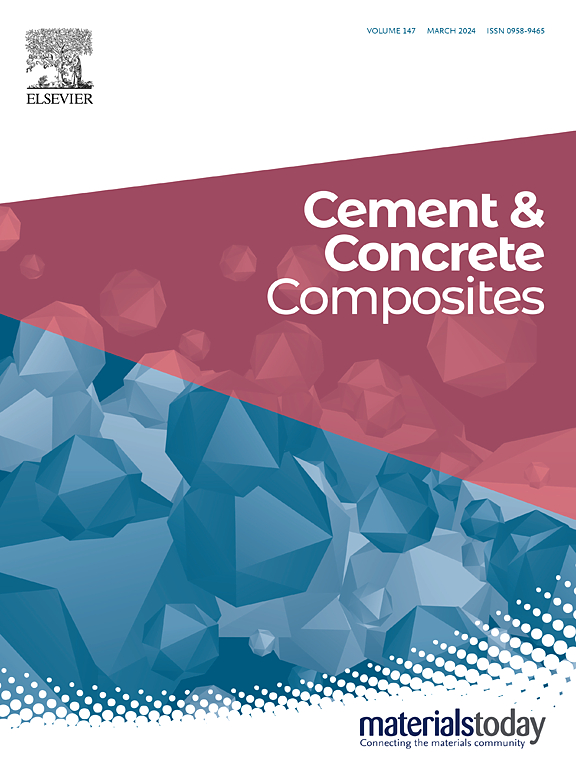用于二氧化碳封存和隔热的多功能高性能水泥气凝胶
IF 13.1
1区 工程技术
Q1 CONSTRUCTION & BUILDING TECHNOLOGY
引用次数: 0
摘要
气凝胶是一种应用广泛的保温材料,但其机械强度低、耐火性差、碳排放高。本文介绍了一种通过水泥原位水化、冷冻浇铸和冷冻干燥制备高力学性能和多功能水泥气凝胶的方法。制备的气凝胶具有三维、多孔、有机-无机层次化的刚性水合铝酸钙硅酸盐分散网络,并通过钙/铝离子配位键和氢键与柔性聚乙烯醇交联。由此产生的水泥气凝胶具有多功能性能,将高机械强度和韧性与热学和环境效益相结合。具体而言,它们的抗压强度为80 MPa,抗弯强度为8.9 MPa,韧性为2260 kJ/m3,同时保持0.465 g/cm3的低密度。由于其无机-有机混合多孔结构,气凝胶具有低导热系数(0.051 W/(m·K))和耐火性。它们的富钙成分和多孔分层结构有利于CO2的吸收和原位矿化成碳酸钙。根据在富含二氧化碳的条件下(30°C, 95%相对湿度)固化28天后的二氧化碳相关质量损失,通过热重分析可以量化碳捕获能力为27.5%。通过将机械加固、隔热和碳封存整合到轻质、可伸缩的水泥气凝胶中,这项工作为可持续建筑和节能基础设施提供了一条引人注目的途径。本文章由计算机程序翻译,如有差异,请以英文原文为准。
Multifunctional high-performance cement aerogels for CO2 sequestration and thermal insulation
Aerogels are widely used as thermal insulation materials, but they suffer from low mechanical strength, poor fire resistance, and high carbon emissions. This paper presents an approach to fabricate cement aerogels with high mechanical performance and multifunctionality via in-situ cement hydration, freeze-casting, and freeze-drying. The fabricated aerogels feature a three-dimensional, porous, organic-inorganic hierarchical network of rigid calcium (aluminate) silicate hydrate dispersed and crosslinked with flexible polyvinyl alcohol via calcium/aluminum ion coordination bonds and hydrogen bonds. The resulting cement aerogels demonstrate multifunctional performance, combining high mechanical strength and toughness with thermal and environmental benefits. Specifically, they achieve a compressive strength of 80 MPa, a flexural strength of 8.9 MPa, and a toughness of 2260 kJ/m3, all while maintaining a low density of 0.465 g/cm3. Owing to their inorganic–organic hybrid porous architecture, the aerogels exhibit low thermal conductivity (0.051 W/(m·K)) and fire resistance. Their calcium-rich composition and porous hierarchical structure facilitate CO2 uptake and in-situ mineralization into calcium carbonate. This results in a carbon capture capacity of 27.5 %, as quantified by thermogravimetric analysis based on CO2-related mass loss after 28 days of curing under CO2-rich conditions (30 °C, >95 % relative humidity). By integrating mechanical reinforcement, thermal insulation, and carbon sequestration into a lightweight and scalable cement aerogel, this work offers a compelling pathway toward sustainable construction and energy-efficient infrastructure.
求助全文
通过发布文献求助,成功后即可免费获取论文全文。
去求助
来源期刊

Cement & concrete composites
工程技术-材料科学:复合
CiteScore
18.70
自引率
11.40%
发文量
459
审稿时长
65 days
期刊介绍:
Cement & concrete composites focuses on advancements in cement-concrete composite technology and the production, use, and performance of cement-based construction materials. It covers a wide range of materials, including fiber-reinforced composites, polymer composites, ferrocement, and those incorporating special aggregates or waste materials. Major themes include microstructure, material properties, testing, durability, mechanics, modeling, design, fabrication, and practical applications. The journal welcomes papers on structural behavior, field studies, repair and maintenance, serviceability, and sustainability. It aims to enhance understanding, provide a platform for unconventional materials, promote low-cost energy-saving materials, and bridge the gap between materials science, engineering, and construction. Special issues on emerging topics are also published to encourage collaboration between materials scientists, engineers, designers, and fabricators.
 求助内容:
求助内容: 应助结果提醒方式:
应助结果提醒方式:


